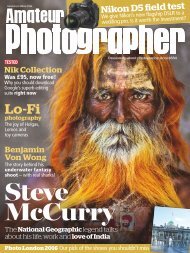You also want an ePaper? Increase the reach of your titles
YUMPU automatically turns print PDFs into web optimized ePapers that Google loves.
Pioneer Rig No. 29<br />
THE STARRY SKIES of lonesome West Texas have inspired<br />
many a cowboy poet. But more recently, the country has become<br />
better known for its pumpjacks and its vast resources beneath<br />
the ground.<br />
The Permian Basin is a vast reach of New Mexico and Texas<br />
home to one of the nation’s greatest fossil fuel deposits. The<br />
boom of recent years in American oil and gas drilling and hydraulic<br />
fracturing — now on the decline — brought bright flames and<br />
facilities for transporting fuel and housing workers.<br />
These oil fields glow at night because drilling and refinery<br />
operations burn off vast amounts of gas to maintain proper pressure<br />
or simply because the flammables are too tough to transport.<br />
Billions of dollars’ worth of fossil fuels are lost to the practice<br />
every year. Floodlights and portable light towers are also found<br />
throughout the oil fields.<br />
This light pollution seeps into Big Bend National Park, another<br />
of the recently minted Dark-Sky Parks.<br />
McDonald Observatory in the nearby Davis Mountains also<br />
looks out onto the Permian Basin. And in 2011, the Texas<br />
Legislature passed a law mandating shields on outdoor lights<br />
throughout the counties surrounding the observatory. But that<br />
didn’t stop the counties to its north from granting some<br />
5,000 oil-drilling permits between 2010 and 2015.<br />
The flares aren’t the biggest problem, either.<br />
Stacey Locke says he, too, learned to love the night under<br />
these heavens. So, as fights erupted between night-sky proponents<br />
and drilling companies, Locke — the CEO and president of<br />
Pioneer Energy Services, which provides contract drilling services<br />
— has become an unlikely ally of the observatory.<br />
In recent years, Locke has teamed with veteran McDonald<br />
Observatory astronomer Bill Wren on a plan to protect the heavens<br />
and the oil exploration. They started with a single, typical site<br />
— Rig No. 29. Even the workers there were unhappy with the<br />
lighting conditions because of glare from “360 lights,” an<br />
unshielded, blast-resistant lamp that cast a dangerous glare on<br />
instrument panels. The workers had crammed a rag into the wire<br />
mesh around the light to help block some of the stray light.<br />
Similar skyglow problems plagued the stairwell.<br />
The study Wren and Locke published based on their work at<br />
Rig No. 29 showed that not only could they improve dark skies in<br />
West Texas, they could also reduce costs and make oil drilling<br />
safer for workers.<br />
They’re often in remote places with<br />
little nearby development and relatively<br />
few visitors. Those parks never had a lot<br />
of lighting to begin with. In contrast,<br />
the Grand Canyon had nearly 5 million<br />
visitors in 2015. And it’s also home to a<br />
town of park workers.<br />
“This is really in many respects<br />
unlike any Dark-Sky Park application<br />
we’ve dealt with before,” says Barentine.<br />
And the herculean effort is even<br />
more remarkable because it comes at a<br />
time when Grand Canyon National Park<br />
is already facing a multibillion-dollar<br />
backlog in maintenance work to repair<br />
leaky water supply pipes and antiquated<br />
infrastructure. Other National Park<br />
Service sites face similar problems.<br />
Dark skies for all parks<br />
But if funding allows, the standards<br />
developed at Grand Canyon will be<br />
rolled out across the parks system.<br />
Anyone with an iPad can now theoretically<br />
go out into the field and catalog<br />
lights, creating an actionable database.<br />
“They would like to get to a model<br />
where essentially almost every national<br />
park unit short of the ones that are in<br />
urban settings would qualify to become a<br />
Dark-Sky Park under the IDA program<br />
because they’ve put a standard set of policies<br />
in place,” Barentine says. “They<br />
would standardize the application process<br />
to the IDA.”<br />
With no nearby cities, Utah’s Vermillion Cliffs National Monument, situated just north of the<br />
Grand Canyon, has some of America’s darkest skies. HARUN MEHMEDINOVIC/SKYGLOWPROJECT.COM<br />
That could help protect these darksky<br />
sanctuaries in perpetuity. Even<br />
remote-sounding national parks like<br />
Rocky Mountain and Joshua Tree have<br />
seen light pollution encroach from<br />
nearby cities. The problems now also<br />
include Alaska’s remote North Slope and<br />
the desolate Bakken region centered in<br />
North Dakota. The boom in production<br />
has created jobs in the previously unpopulated<br />
region. And that new residential<br />
and commercial infrastructure is bringing<br />
new lights near Theodore Roosevelt<br />
National Park. The impact is most obvious<br />
when seen from space. NASA photos<br />
show how the Bakken region became one<br />
of the brightest regions in the West in<br />
just a few short years. Its skyglow rivals<br />
that of large metropolitan areas. The<br />
same is true of shale oil fields in Texas.<br />
(See “Pioneer Rig No. 29,” above.)<br />
“The place you are in is special, but it<br />
shouldn’t be in a sense,” Barentine says<br />
to a group of skywatchers standing near<br />
Mather Point. “Of course, the Grand<br />
Canyon is great and we can’t reproduce<br />
it everywhere on Earth, but the night<br />
sky over the Grand Canyon is something<br />
that we can bring back if we so choose to<br />
do that.”






